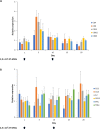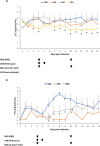Safety and efficacy of a mesenchymal stem cell intramammary therapy in dairy cows with experimentally induced Staphylococcus aureus clinical mastitis
- PMID: 32071371
- PMCID: PMC7028716
- DOI: 10.1038/s41598-020-59724-7
Safety and efficacy of a mesenchymal stem cell intramammary therapy in dairy cows with experimentally induced Staphylococcus aureus clinical mastitis
Abstract
Although, antibiotics are effective in the treatment of bovine mastitis, they do not address the regeneration of mammary glandular tissue and have been associated to the increment in antimicrobial resistance worldwide. Considering the necessity of alternative therapies for this disease of high economic impact and the reported regenerative and antibacterial effects of mesenchymal stem cell (MSCs), we evaluated the safety and efficacy of an allogenic MSC-based intramammary therapy in dairy cows with experimentally induced Staphylococcus aureus clinical mastitis. In a safety trial, heifers were inoculated intramammarily with a 2.5 × 107-suspension of bovine fetal AT-MSCs on experimental days 1 and 10. Animals were evaluated clinically on a daily basis during a 20-day experimental period and blood samples were collected for hemogram determination and peripheral blood leukocytes (PBLs) isolation. In an efficacy trial, Holstein Friesian cows were inoculated with S. aureus and treated intramammarily with vehicle (NEG; days 4 and 10), antibiotics (ATB; days 4 and 5) or a suspension of 2.5 × 107 AT-MSCs (MSC; days 4 and 5). Cows were clinically evaluated daily and milk samples were collected for somatic cell count (SCC) and colony forming units (CFU). Blood samples were collected for serum haptoglobin and amyloid A determination. Intramammary administration of two doses of bovine fetal AT-MSCs in healthy cows did not induce changes in clinical or hematological variables, and gene expression profiles in PBLs associated to activation (CD4, CD8, CD25, CD62L and CD69) and proinflammatory cytokines (CCL2, CCL5, IL2, CXCL3, IFNγ, and TNFα). Quarters of MSC group of cows had similar SCC log/mL in milk compared to infected quarters of ATB or NEG cows. However, quarters of MSC cows had lower CFU log/mL in milk compared to quarters of NEG cows. Intramammarily inoculation of repeated doses of 2.5 × 107 allogenic AT-MSCs did not induce clinical or immunological response in healthy cows. Moreover, MSC-intramammary treatment reduced bacterial count in milk of cows with S. aureus clinical mastitis compared to untreated cows. This work provides initial evidence for the safety and efficacy of an allogenic MSC-based intramammary therapy for the treatment of bovine mastitis.
Conflict of interest statement
The authors declare no competing interests.
Figures



References
Publication types
MeSH terms
LinkOut - more resources
Full Text Sources
Other Literature Sources
Medical
Research Materials

